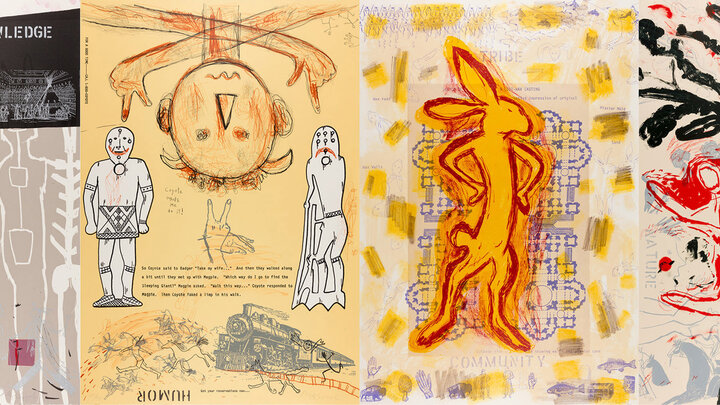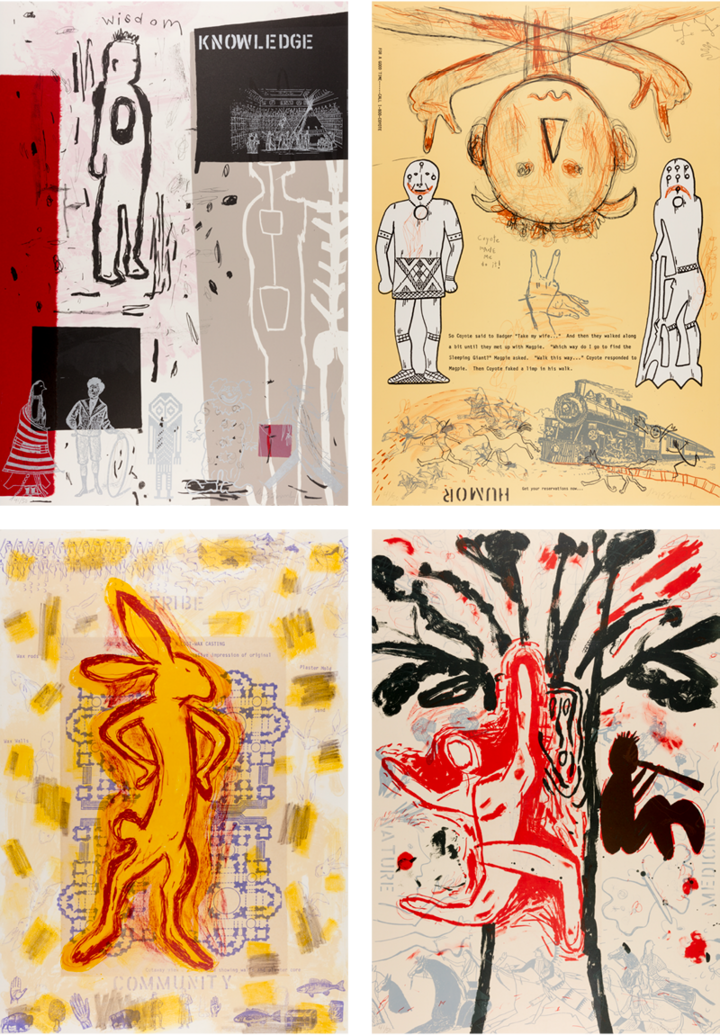
Sheldon Museum of Art recently purchased Survival Suite, a portfolio of four lithographs by Jaune Quick-to-See Smith, an enrolled Squelix’u (Salish) member of the Confederated Salish and Kootenai tribes in the US state of Montana. The prints are titled Wisdom/Knowledge, Humor, Tribe/Community, and Nature/Medicine. They are named for the Native American social models that have imbued indigenous people with resilience in the face of repeated trauma, most notably the forced relocation and mass genocide brought about by the United States’ program of westward expansion from the mid-nineteenth century onward.
Now active in New Mexico, Smith first came to national prominence during the 1970s. She is best known for her paintings and prints that engage with contemporary tribal politics, human rights, and environmental issues. Because of the personal nature of many of her works, descriptions of Smith often reduce her to an artist whose work solely engages with Native American themes. Her contributions to American modernism, best seen in Tribe/ Community and her use of the rabbit, have often been overlooked. Much of the literature on Smith highlights the importance of this small mammal as a trickster animal for many Native Americans, including Muscogee and Winnebago tribes. Generally considered a lighthearted character, the Rabbit Trickster features in many children’s stories and is prone to some inappropriate behavior, such as gluttony, carelessness, and an overinflated ego. Discussions of Smith’s work tend to gloss over the fact that she also is working within a long tradition of artists who have included the rabbit in their work, most notably Joseph Beuys’s dead hare in How to Explain Pictures to a Dead Hare (1965) and Jeff Koons’s highly reflective stainless steel Rabbit (1986), a multiple of which one in the edition of three recently caused a sensation at auction.
In Tribe/Community, Smith skillfully merges these two traditions (modernism and rabbits) in her anthropomorphic rabbit. Standing boldly on its two hind legs and with its front limbs akimbo, Smith’s rabbit cuts a defiant figure, its determination radiating outward in red through a series of quickly drawn strokes of a greasy lithographic crayon. The rabbit is superimposed on four identical Latin cross church floorplans, symbols of the European Christocentric world view that was used to justify Manifest Destiny’s systematic persecution of indigenous populations. In this print, the rabbit is a potent figure of resistance, grit, and resilience, themes that Smith addresses in the rest of the portfolio.
Smith's Survival Suite is a recent acquisition featured in the 2020 exhibition Person of Interest.

born St. Ignatius, MT 1940
Wisdom/Knowledge, Humor, Tribe/Community, Nature/Medicine (from Survival Suite)
Color lithographs, 1996
36 × 24 7/8 inches
Sheldon Museum of Art, University of Nebraska–Lincoln, Robert E. Schweser and Fern Beardsley Schweser Acquisition Fund, through the University of Nebraska Foundation, U-6850.1–4.2019